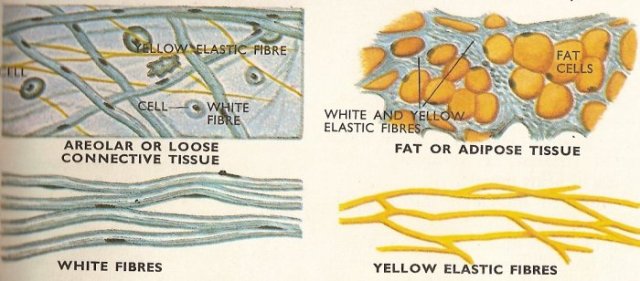CONNECTIVE TISSUE
1. Connective tissues are mesodermal in origin.
2. Connective tissue is responsible for providing maintaining body form.
3. Connective tissue is formed by cells and extra cellular matrix
4. Extra cellular matrix consists of protein fibres and ground substance.
5. Ground substance contains water, polysaccharides and proteins.
6. Protein fibres are collgen, reticular and elastic in nature.
7. The ground substance is the medium through which nutrients and metabolic wastes are exchanged between cells and their blood supply.

1. Cells of connective tissue:
(Give a brief account of cells of connective tissue? 4 marks)
Connective tissue contains a variety of cells
1. Fibroblast cells: Active fibroblasts produce fibres. The in-active cells are calleed fibrocytes.
2. Mast cells: They produce heparin, histamine, bradykinin. Heparin acts as anty-coagulant . Histamin and bradykinin cause vasodilation and increases vacular permeability.
3. Macrophages: These are phagocytic cells. Monocytes in the blood that enter connctive tissue, mature and become macrophages. Macrophages are phagocytic and also act as internal scavengers. They engulf bacteria and debris.
4. Plasma cells: These are large, ovoid cells. Plasma cells synthesize antibodies. They are derived from B-Lymphocytes.
5. Adipocytes: These are specialized for storage of fats and for the production of heat.
6. Leucocytes: These are migrate from the blood vessels into connective tissues by diapedesis.
2. Fibres of connective tissue:
(Give an account of fibres of connective tissues? 4marks)
Three types of fibres occur in the connective tissue. They are:
a) Collagen fibres
b) Recticular fibres
c) Elastic fibres
1. Collagen and Elastic fibres are formed by collagen.
2. Elastic fibres are composed of elastin.
3. Collagen fibres: White in colour. Occur in bundles. Strong and stretch resistant.
4. Reticular fibres: Extremely thin and branched.Form an extensive network.Provide support and strength.
5. Elastic fibres: Yellow in colour. Branched fibres. Strong but can be stretched and are capable to return to original shape.
